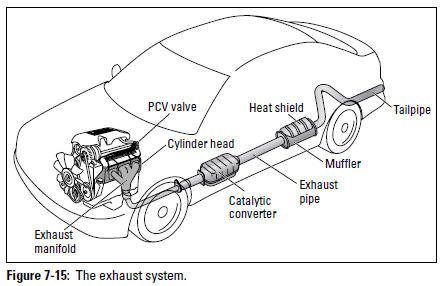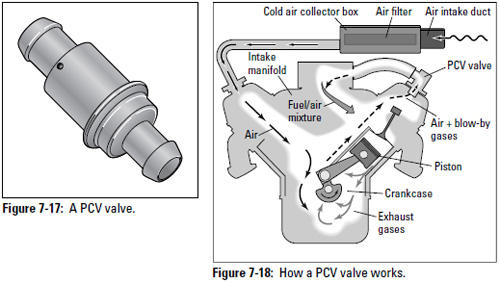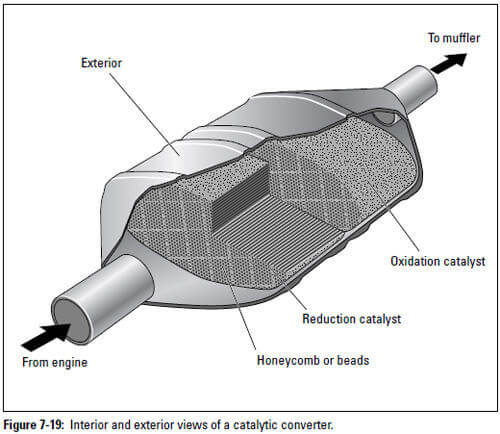The exhaust system, shown in Figure 7-15, is the waste disposal system of your vehicle. When the fuel system brings the fuel and air together in the cylinders to drive the vehicle, waste products are formed, and some of themare toxic.
Now that people all over the world are finally aware of how toxic exhaust gases can be for people and how drastically they affect global warming, it's really important to understand the system that works to detoxify these pollutants and disburse them as safely as possible.

|
As the exhaust gases pass from the cylinders in the engine through the muffler to the tailpipe at the rear of the vehicle and into the air, emissions control devices — including the PCV valve, various sensors, a catalytic converter, and other components — work to reduce or remove the harmful substances and recycle unburned fuel vapors.
Tip: There's little you can do to maintain or repair most of the parts in the exhaust system except to check and clean your PCV valve and replace it, if necessary; and troubleshoot to see whether your catalytic converter needs to be replaced. If the converter, the tailpipe, or the muffler needs to be replaced, have the job done by a professional.
The Muffler
Exhaust pipes carry what's left of the exhaust gases through a muffler, which controls the noise of the escaping gases to the tailpipe and out of the vehicle (see Figure 7-16). If it fails, you can get a ticket, probably for disturbing the peace! Besides keeping the noise down, the muffler also has an effect on the pressure required to pass the exhaust gases through it, which creates the "back pressure" that the engine requires to run efficiently and affects the temperature and therefore the efficiency of thecatalytic converter.

|
The PCV Valve
The PCV valve (shown in Figure 7-17) is part of the positive crankcase ventilation system, which reroutes unburned gases, or blow-by, from the crankcase to the intake manifold and back to the engine, where they can be reburned in the cylinders. This process cuts the amount of pollution released into the environment. It also increases fuel economy because unburned fuel in the blow-by is consumed the second time around. The PCV valve also extends the life of the engine by reducing the water vapor and acid deposits that contaminateoil and form engine sludge. Figure 7-18 shows you how the PCV valve works.

|
The Catalytic Converter
The catalytic converter (shown in Figure 7-19) is usually attached to the exhaust pipe just after the exhaust manifold pipes. It was developed to deal with smog by further reducing the toxic substances in the exhaust gases before they can pollute the air. The catalytic converter is basically a cylinder filled with either little ceramic beads or a honeycomb structure coated withminute amounts of expensive metal catalysts that interact with the pollutants:
- Reduction catalysts (rhodium and palladium) turn the NOx (nitrogen oxide) emissions to oxygen and nitrogen, which exist in the air we breathe.
- Oxidation catalysts (palladium and platinum) turn carbon monoxide and hydrocarbon into harmless carbon dioxide and water.
The use of catalytic converters brought about another development that has been of great benefit to the environment. Originally, the lead in gasoline fouled catalytic converters, rendering them less effective and eventually destroying them, so legislation was passed to remove lead from fuel. Because lead is toxic to humans and other animals, we've all benefited greatly from its removal from automotive fuel and its emissions.

|
Other Emissions Control Devices
Other emissions control devices include an exhaust gas recirculation system (EGR). An EGR valve on the intake manifold allows a small percentage of the exhaust gases back into the intake manifold, which lowers the peak combustion temperature in the combustion chambers and results in lower NOx emissions. Also, oxygen sensors tell the ECU about excess oxygen in the exhaust gases so that the ECU can correctly control the fuel/air mixture. Air injection systems and various other gizmos also help clean up theexhaust before it enters the air.
Engineers are developing new ways to clean up and reduce automotive emissions every day. All you need to know is that the parts and processes are there, and they’re working to keep you healthy. But the healthiest thing you can do is drive the most-efficient vehicle possible, as little as possible!
From Auto Repair for Dummies, copyright © 2009 by Wiley Publishing, Inc., Indianapolis, Indiana. Used by arrangement with John Wiley & Sons, Inc.










